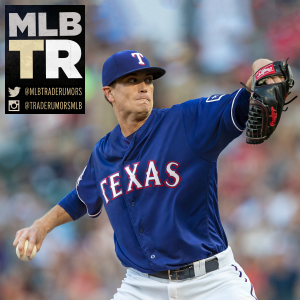The Rangers announced a series of roster moves Tuesday, most notably placing right-hander Kyle Gibson on the 10-day injured list due to a right groin strain. Texas also placed righty Hunter Wood on the IL with a fairly ominous designation of “right elbow discomfort.” Gibson’s placement is retroactive to May 22, while Wood’s is backdated to May 23. No timeline was provided for either pitcher, though Evan Grant of the Dallas Morning News tweets that the initial hope is Gibson will only be forced to miss a pair of starts. In their place, lefty Wes Benjamin and righty Demarcus Evans were recalled from Triple-A.
It’s a sudden and unexpected development for the Rangers, though the expectation of a relatively brief absence is good news for the club and its fans. Gibson, 33, was absolutely shelled for five runs in a third of an inning in his 2021 debut, but he’s been one of the best pitchers on the planet in nine starts since that time. Dating back to April 7, the longtime Twins righty has pitched to a 1.50 ERA with a 20.3 percent strikeout rate, a 6.9 percent walk rate and a 52.7 percent ground-ball rate.
The 2021 season is the second of three in a $28MM contract Gibson inked with Texas back in the 2019-20 offseason. The first of his three years on the deal didn’t go well at all — 5.35 ERA in 67 1/3 innings — but like Mike Minor and Lance Lynn before him in Texas, he’s now exceeded all expectations on a three-year pact that surprised some onlookers. For a Rangers club that is 22-27 at the moment, losing its best starter even for a brief period of time is a notable hit to absorb.
Of course, the Rangers weren’t expected to contend this season anyhow, as the club has been outspoken about its decision to move in a younger direction. With that in mind, Gibson’s run of excellence and a contract that now looks eminently affordable would make him one of this summer’s most obvious trade candidates — provided today’s injury indeed proves to be minor in nature. Should he require a lengthier stint, experience a setback in rehab and/or deal with additional groin issues down the road, that could adversely impact the Rangers’ ability to extract a strong return in a trade.
Wood, 27, signed a minor league deal with the Rangers and was called to the big league club not long ago. He’s tossed five innings and held the opposition to a pair of runs, making for a fine start to his Texas tenure. The right-hander has a solid track record at the MLB level, having compiled a 3.34 ERA in 91 2/3 frames between Tampa Bay, Cleveland and his new surroundings in Texas. The hope, as always, is that the elbow discomfort proves to be minor, but the lack of specificity suggests the Rangers will perform additional testing to determine what’s at play.
